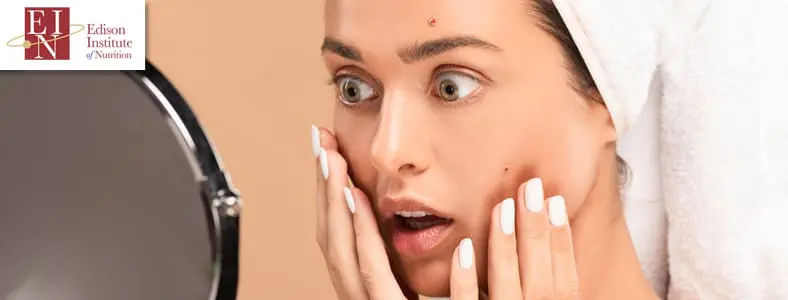
Beauty is only skin deep.
But sometimes there’s no need to look any deeper, as your skin can also reveal the inner workings of your body and your health.
If you are healthy, your skin will usually reflect that.
But your skin can also give you the first warning signs that something is up.
Your skin on the outside reflects what can be out of balance on the inside.
A holistic nutritionist will be able to tell you what your symptoms may reveal.
So how can you recognize these signs for yourself?
How can you use this knowledge to help others?
Perhaps you are interested in a career as a holistic nutritionist, where you can help others to live a healthier lifestyle.
Or maybe you’re simply looking to enrich your own knowledge of holistic nutrition through an introduction to holistic nutrition program.
Taking holistic nutrition courses online through the Edison Institute of Nutrition can get you there.
Let’s take closer look at some of the health issues revealed by your skin, and how a healthy diet through holistic nutrition can help.
The Outside Reflects The Inside
The skin is your body’s natural barrier against the outside world.
It provides protection from bacteria, regulates body temperature, and protects you from the harmful UV rays of the sun.
The skin is the largest organ in your body.
It is also sometimes the first indication you have that something could be going on inside.
Here are some of the more serious health conditions that can show up on your skin.
Shingles
The development of any rash is something to be concerned about, but in the case of shingles, fast action is necessary.
Most people do not recognize shingles when it first appears, as it starts slowly before spreading into a blistering, burning rash.
Shingles is a viral infection (a form of herpes) that comes from the same virus that causes chicken pox in children.
If you are an adult who has had chicken pox, the virus exists in your system and can reactivate, causing the nerves to flare up into a painful rash.
Symptoms Of Shingles On Your Skin
Symptoms of shingles begin as an itching or burning sensation on your skin, which develop into a rash that travels in a line across the body.
Rashes do not usually appear on both sides of the body at once, stopping at the midline.
As the virus progresses, the rash may develop in more than one area of the body, and can appear on your torso, face or shoulders.
The rash forms blisters on your skin that are very painful to the touch, and are sometimes, but not always, accompanied by fever.
A first appearance of the rash can be mistaken for insect bites or hives, but it is important to check with your doctor as early intervention is key.
Left untreated, the virus can persist for two to six weeks, and in some cases it leaves nerve damage that can be painful for months.
Holistic Nutrition Solutions For Shingles
The blisters of a shingles rash can spread the infection, so it is important to keep them clean.
Cool baths, cold compresses, and soothing pastes made with colloidal oatmeal or cornstarch help to soothe the burning.
A shingles appearance is often triggered by a weakened immune system or stress.
Eating properly to boost your immune system will prevent the virus from spreading quickly.
A shingles diet consists of foods rich in vitamins A, B12, C, and E, as well as lysine, such as:
- Tomatoes
- Spinach and leafy greens
- Legumes and beans
- Whole grains
- Orange and yellow fruits
- Red meat
- Dairy
- Chicken
In order to heal faster, avoid certain foods, especially:
- Saturated fats
- Trans fats
- Foods high in carbohydrates
- Foods loaded with sugar
- Arginine rich foods such as nuts and gelatin
Diabetes
Type 2 diabetes is one of the most prominent diseases in North America, with over 300 million people affected worldwide.
Diabetes occurs when the body becomes insulin resistant and blood sugar levels become life threatening.
You can look to your skin for signs that you may be at risk.
Symptoms Of Diabetes On Your Skin
Thickened, shiny areas on the skin, also called “plaque”, are a sign that you have high blood sugar.
Areas of darkened skin tone, or hyper pigmentation, also reflect a possible case of diabetes.
As you develop diabetes, your skin suffers from the effects of high blood sugar.
This results in loss of sensation and circulation in various extremities such as your hands, feet, and legs.
People with diabetes can develop cuts on their feet without knowing they are there.
Once the skin has become compromised, it loses the ability to fight off infection, so if you have diabetes, it is important to check your skin regularly for issues.
Holistic Nutrition Solutions For Diabetes
There is a strong connection between type 2 diabetes and an unhealthy diet.
If you have been diagnosed with diabetes, your primary concern should be reducing your blood sugar.
Eating a diet rich in antioxidants (one of the health benefits of goji berries, high in fiber, and low in carbohydrates will help to reduce your risk of developing diabetes and control your sugar levels.
Here are some of the top foods to eat:
- Antioxidant rich vegetables such as broccoli, squash, garlic, and leafy greens
- Anti inflammatory fruits like avocado and strawberries
- Fish, eggs, and other low carb, high fat dairy products
- Oils such as olive oil and flax seed oil for their antioxidant properties
- Food high in fiber that make you feel full, like beans, nuts, and chia seeds
One of the health benefits of drinking coffee is that it’s been connected to a reduced risk of developing diabetes due to the presence of magnesium and potassium.
Foods to avoid if you have diabetes include:
- Fruit juice and other sugary beverages
- Refined or processed carbohydrates such as white bread and white pasta
- Alcohol
- Processed meats
- Fried foods
High Cholesterol
High cholesterol puts you at much greater risk of heart disease and stroke.
Most of us have our cholesterol checked on a regular basis with our family doctor.
But your skin will alert you to more rare cholesterol disorders if your cholesterol levels are at a dangerously high level.
Symptoms Of High Cholesterol On Your Skin
If high levels of cholesterol go untreated, cholesterol deposits become visible in the skin.
The skin develops yellowish bumps known as xanthelasma or xanthomas.
This type of cholesterol disorder is rarer and usually tied to a genetic or liver disorder.
Holistic Nutrition Solutions For High Cholesterol
Diet is a good way to fight high cholesterol.
Reduce your risk of developing high cholesterol by adding the following to your diet:
- High fibre foods such as whole grains, fruits, and vegetables
- Garlic supplements
- Soy protein
- Natural vegetable fat supplements
Avoid the bad fats, especially hydrogenated fats that appear in fried foods, processed animal products, and baked snacks.

Liver Disease
The liver is the primary organ for detoxification in the body, and when it’s malfunctioning your energy reserves are affected.
Liver diseases include hepatitis C, which is inflammation of the liver, or cirrhosis, in which scar tissue appears in the liver in place of healthy tissue.
Cirrhosis can develop as a result of hepatitis C, alcoholism, or fatty liver disease, all of which can become chronic and lead to long term liver failure.
Signs Of Liver Disease On Your Skin
Itchy skin could be an early warning sign of liver disease.
If the itch lasts longer than six weeks, then it’s a good idea to have your liver checked.
If you notice red, raised bumps on your legs, this could be a sign of hepatitis C.
Holistic Nutrition Solutions For Liver Disease
A liver-friendly diet contains foods high in chlorophyll, sulfur compounds, and flavonoids.
These include:
- avocado
- dark, leafy greens
- turmeric
- beets
- cruciferous vegetables such as broccoli, cauliflower, and cabbage
- garlic
Avoiding processed foods, alcohol, and tobacco will lower your risk of developing fatty liver disease.
Drink lots of water to ensure your body has what it needs to eliminate toxins.
Polycystic Ovarian Syndrome (PCOS)
Polycystic ovary syndrome (PCOS) is one of the more common endocrine conditions and occurs in cis women of reproductive age.
The main causes of PCOS are insulin resistance and hormonal imbalance.
Symptoms of PCOS include:
- thinning hair
- irregular periods
- ovarian cysts
- persistent acne
Our skin can alert us to the presence of this syndrome.
Symptoms Of PCOS On Your Skin
PCOS symptoms on the skin include cystic acne that does not disappear when treated.
In addition, thickening of your facial hair may be a sign of PCOS.
If you have these symptoms, speak to your doctor.
An adjustment to your diet will also help you to manage your symptoms.
Holistic Nutrition Solutions For PCOS
As PCOS syndrome manifests in insulin resistance and hormonal imbalance, the best diet is one rich in whole foods and low in refined sugars.
Protein helps to stimulate the production of insulin in your body, so try to balance healthy carbs with plant-based protein sources such as nuts and whole grains.
PCOS is an anti-inflammatory condition, so add anti inflammatory options such as olive oil, fatty fish, and tomatoes.
Up your fiber intake and limit caffeine.
Avoid processed meats and foods that may contain hormones or preservatives.
Supplements to counteract insulin resistance and hormone imbalance are also encouraged.
Contact Edison Institute of Nutrition
If you wish to learn more about the role nutrition can play in a balanced lifestyle, then why not take a course through Edison Institute of Nutrition?
Perhaps you have considered a career as a holistic nutritional therapist, or you are already working as one and want to enhance your knowledge through our continuing education program.
Helping clients to make positive changes in their lives is one of the most fulfilling aspects of this career.
Courses are offered around the world through our in depth, online distance learning program.
Contact Edison Institute of Nutrition today to make your first move towards a healthy future.
